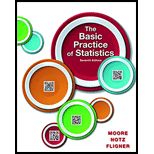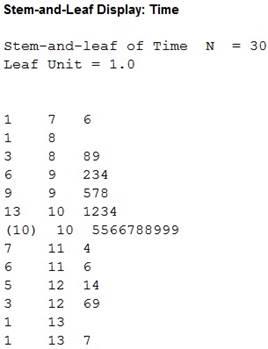
Concept explainers
a.
To make: A stem plot for the times customers spent in the restaurant on the next Saturday evening.
a.
Answer to Problem 19.56SE

Explanation of Solution
The given data represent the time spent by the customers in the restaurant on the next Saturday evening. The
Calculation:
Software procedure:
Step-by-step software procedure to draw stemplot using MINITAB software is as follows:
- Select Graph > Stem and leaf.
- Select the column of Time in Graph variables.
- Select OK.
Observation:
Symmetric distribution:
When the left and right sides of the distribution are approximately equal or mirror images of each other, then it is a symmetric distribution.
In the stemplot, the observations of the data set are extended to the left and to the right in a bell shape. Thus, the stemplot shows that data of times are symmetrically distributed.
The
A observation is a suspected outlier, if it is more than
Software procedure:
Step-by-step software procedure for first
- Choose Stat > Basic Statistics > Display
Descriptive Statistics . - In Variables enter the columns Time.
- Choose option statistics, and select first quartile, third quartile, inter quartile
range . - Click OK.
Output using the MINITAB software is as follows:

From Minitab output, the first quartile is 96.50, third quartile is 110.25, and
Substitute IQR in the
The
b.
To check: Whether there is a reason to think that the lavender odor has increased the mean time customers spent in the restaurant or not.
b.
Answer to Problem 19.56SE
Yes, there is a reason to think that the lavender odor has increased the mean time customers spent in the restaurant.
Explanation of Solution
The standard deviation
Calculation:
STATE:
In France, pizza restaurant owner knows the time customers spend in the restaurant on Saturday evening. The mean time spent by the customers in the restaurant is 90 minutes. Is there any reason to think that the lavender odor increased the mean time spent in the restaurant?
PLAN:
Parameter:
Define the parameter
The hypotheses are given below:
The claim of the problem is increase in mean time of customers spent in the restaurant.
Null Hypothesis:
That is, the mean time is equal to 90 minutes.
Alternative hypothesis:
That is, the mean time is greater than 90 minutes. Hence, the alternative hypothesis is one sided.
SOLVE:
Conditions for valid test:
A sample of 20 timings of a restaurant is randomly selected and times follow
Test statistic and P-value:
Software procedure:
Step-by-step procedure to obtain test statistic and P-value using the MINITAB software:
- Choose Stat > Basic Statistics > 1-Sample Z.
- In Samples in Column, enter the column of Times.
- In Standard deviation, enter15.
- In Perform hypothesis test, enter the test mean 90.
- Check Options, enter Confidence level as 95.
- Choose greater than in alternative.
- Click OK in all dialogue boxes.
Output using the MINITAB software is given below:

From the MINITAB output, the test statistic is 5.73 and the P-value is 0.000.
Decision criteria for the P-value method:
If
If
CONCLUDE:
Use a significance level,
Here, P-value is 0.000, which is less than the value of
That is,
Therefore, the null hypothesis is rejected.
Thus, there is good evidence that the mean time of customers who spent in the restaurant is increased.
Want to see more full solutions like this?
Chapter 19 Solutions
BASIC PRAC OF STATISTICS+LAUNCHPAD+REE
- For a binary asymmetric channel with Py|X(0|1) = 0.1 and Py|X(1|0) = 0.2; PX(0) = 0.4 isthe probability of a bit of “0” being transmitted. X is the transmitted digit, and Y is the received digit.a. Find the values of Py(0) and Py(1).b. What is the probability that only 0s will be received for a sequence of 10 digits transmitted?c. What is the probability that 8 1s and 2 0s will be received for the same sequence of 10 digits?d. What is the probability that at least 5 0s will be received for the same sequence of 10 digits?arrow_forwardV2 360 Step down + I₁ = I2 10KVA 120V 10KVA 1₂ = 360-120 or 2nd Ratio's V₂ m 120 Ratio= 360 √2 H I2 I, + I2 120arrow_forwardQ2. [20 points] An amplitude X of a Gaussian signal x(t) has a mean value of 2 and an RMS value of √(10), i.e. square root of 10. Determine the PDF of x(t).arrow_forward
- In a network with 12 links, one of the links has failed. The failed link is randomlylocated. An electrical engineer tests the links one by one until the failed link is found.a. What is the probability that the engineer will find the failed link in the first test?b. What is the probability that the engineer will find the failed link in five tests?Note: You should assume that for Part b, the five tests are done consecutively.arrow_forwardProblem 3. Pricing a multi-stock option the Margrabe formula The purpose of this problem is to price a swap option in a 2-stock model, similarly as what we did in the example in the lectures. We consider a two-dimensional Brownian motion given by W₁ = (W(¹), W(2)) on a probability space (Q, F,P). Two stock prices are modeled by the following equations: dX = dY₁ = X₁ (rdt+ rdt+0₁dW!) (²)), Y₁ (rdt+dW+0zdW!"), with Xo xo and Yo =yo. This corresponds to the multi-stock model studied in class, but with notation (X+, Y₁) instead of (S(1), S(2)). Given the model above, the measure P is already the risk-neutral measure (Both stocks have rate of return r). We write σ = 0₁+0%. We consider a swap option, which gives you the right, at time T, to exchange one share of X for one share of Y. That is, the option has payoff F=(Yr-XT). (a) We first assume that r = 0 (for questions (a)-(f)). Write an explicit expression for the process Xt. Reminder before proceeding to question (b): Girsanov's theorem…arrow_forwardProblem 1. Multi-stock model We consider a 2-stock model similar to the one studied in class. Namely, we consider = S(1) S(2) = S(¹) exp (σ1B(1) + (M1 - 0/1 ) S(²) exp (02B(2) + (H₂- M2 where (B(¹) ) +20 and (B(2) ) +≥o are two Brownian motions, with t≥0 Cov (B(¹), B(2)) = p min{t, s}. " The purpose of this problem is to prove that there indeed exists a 2-dimensional Brownian motion (W+)+20 (W(1), W(2))+20 such that = S(1) S(2) = = S(¹) exp (011W(¹) + (μ₁ - 01/1) t) 롱) S(²) exp (021W (1) + 022W(2) + (112 - 03/01/12) t). where σ11, 21, 22 are constants to be determined (as functions of σ1, σ2, p). Hint: The constants will follow the formulas developed in the lectures. (a) To show existence of (Ŵ+), first write the expression for both W. (¹) and W (2) functions of (B(1), B(²)). as (b) Using the formulas obtained in (a), show that the process (WA) is actually a 2- dimensional standard Brownian motion (i.e. show that each component is normal, with mean 0, variance t, and that their…arrow_forward
- The scores of 8 students on the midterm exam and final exam were as follows. Student Midterm Final Anderson 98 89 Bailey 88 74 Cruz 87 97 DeSana 85 79 Erickson 85 94 Francis 83 71 Gray 74 98 Harris 70 91 Find the value of the (Spearman's) rank correlation coefficient test statistic that would be used to test the claim of no correlation between midterm score and final exam score. Round your answer to 3 places after the decimal point, if necessary. Test statistic: rs =arrow_forwardBusiness discussarrow_forwardBusiness discussarrow_forward
 MATLAB: An Introduction with ApplicationsStatisticsISBN:9781119256830Author:Amos GilatPublisher:John Wiley & Sons Inc
MATLAB: An Introduction with ApplicationsStatisticsISBN:9781119256830Author:Amos GilatPublisher:John Wiley & Sons Inc Probability and Statistics for Engineering and th...StatisticsISBN:9781305251809Author:Jay L. DevorePublisher:Cengage Learning
Probability and Statistics for Engineering and th...StatisticsISBN:9781305251809Author:Jay L. DevorePublisher:Cengage Learning Statistics for The Behavioral Sciences (MindTap C...StatisticsISBN:9781305504912Author:Frederick J Gravetter, Larry B. WallnauPublisher:Cengage Learning
Statistics for The Behavioral Sciences (MindTap C...StatisticsISBN:9781305504912Author:Frederick J Gravetter, Larry B. WallnauPublisher:Cengage Learning Elementary Statistics: Picturing the World (7th E...StatisticsISBN:9780134683416Author:Ron Larson, Betsy FarberPublisher:PEARSON
Elementary Statistics: Picturing the World (7th E...StatisticsISBN:9780134683416Author:Ron Larson, Betsy FarberPublisher:PEARSON The Basic Practice of StatisticsStatisticsISBN:9781319042578Author:David S. Moore, William I. Notz, Michael A. FlignerPublisher:W. H. Freeman
The Basic Practice of StatisticsStatisticsISBN:9781319042578Author:David S. Moore, William I. Notz, Michael A. FlignerPublisher:W. H. Freeman Introduction to the Practice of StatisticsStatisticsISBN:9781319013387Author:David S. Moore, George P. McCabe, Bruce A. CraigPublisher:W. H. Freeman
Introduction to the Practice of StatisticsStatisticsISBN:9781319013387Author:David S. Moore, George P. McCabe, Bruce A. CraigPublisher:W. H. Freeman





